We are devoted to develop novel mechanism-based soft sensors that can meet the requirements of low-detection limit, repeatability, and durability for real-world applications in robotics, wearables, healthcare systems and human-machine interactions. And we also investigate sensor related enabling technologies, from sensing electronics, signal processing, multi-sensor fusion, to advanced fabrications and functional materials.
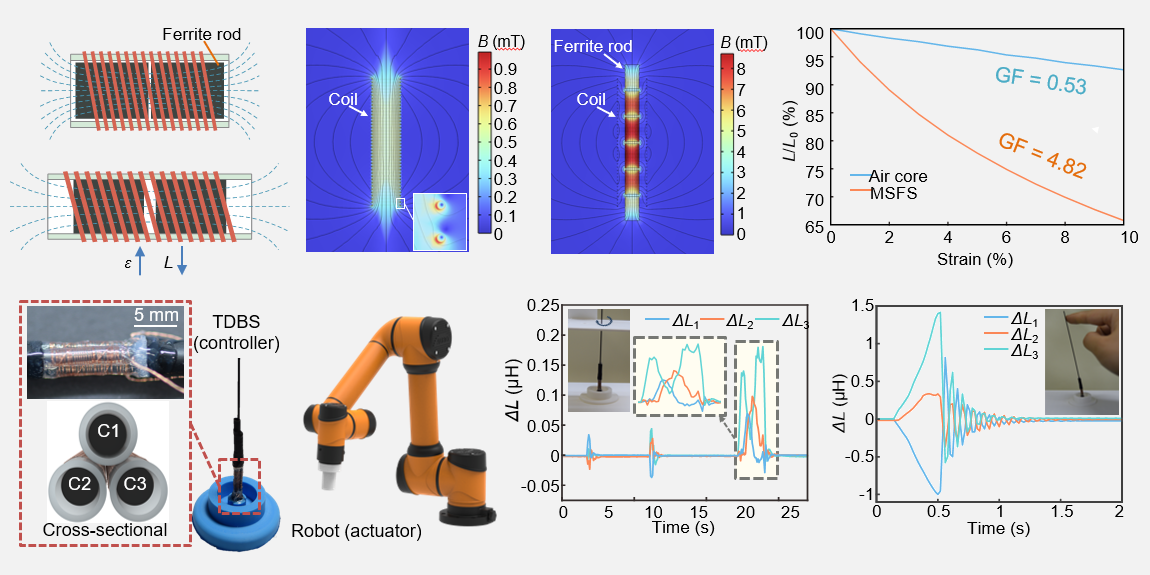
Omnidirectional Bending Sensors
This work proposes a multi-ferromagnetic core enhanced stretchable inductive strain sensor (MSFS), exploiting the magnetic reluctance changes of air-gaps between ferro-cores. A 1 mm diameter helical coil MSFS achieved a ultrahigh strain sensing resolution of 0.001% in a wide range up to 10%. The MSFS has a gauge factor (GF) of 4.82, 9 times of the air core sensor with a GF of 0.53. Building on this, three MSFS were assembled together as a bundle for omnidirectional bending detection, showing promising features in human-machine interactions, as well as in wearables.
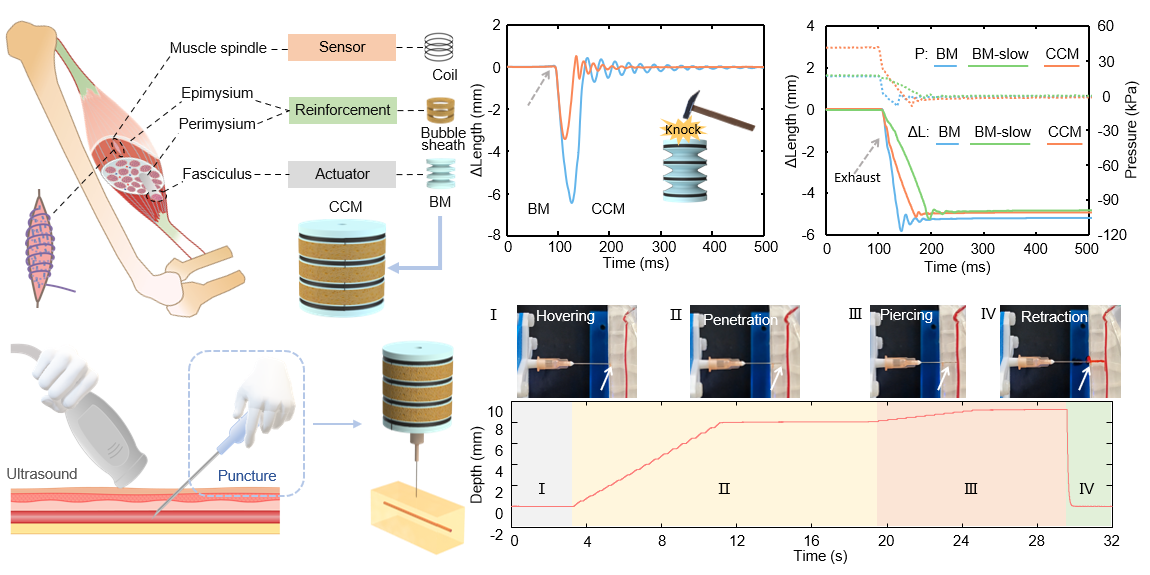
Micrometer-Precision Artificial Muscles
Inspired by the fascia in biological muscle systems, this work presents a composite cylindrical muscle (CCM), which exploit a closed-cell silicone foam sheath on valleys of a bellows-type pneumatic artificial muscle. The CCM achieves a 70% reduction in overshoot and vibration under rapid actuation and external impact, and 5 μm-level precise motion. In addition, we demonstrate that the CCM’s stability and precision in needle insertion applications.
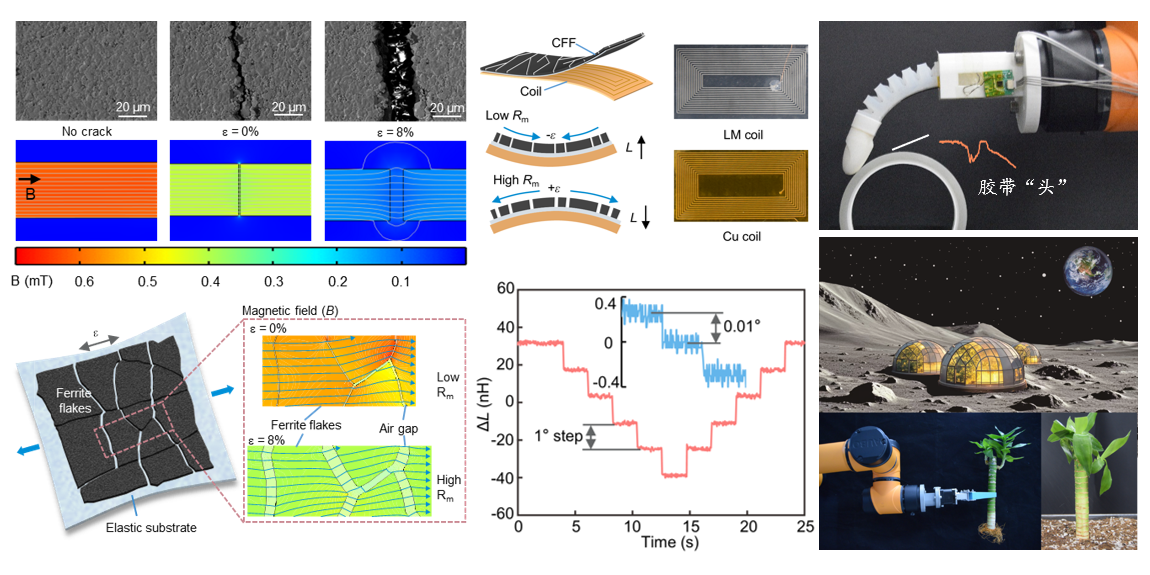
Magnetic Crack-based Pizeoinductive Sensors (MC-PIS)
In this study, we present a magnetic crack-based piezoinductive sensor (MC-PIS), which exploits magnetic flux variation of a cracked ferrite film (CFF) and its resultant effect on the inductance of an electric coil placed below the ferrite film. It can detect bidirectional bending with a precision of 0.01° from -200° to 327°, showing maintained performance when submerged in hot and cold water, scratched in half, or run over by a car. The MC-PIS opens a new paradigm to develop ultrasensitive yet extreme robust sensors in real-world robotics applications.
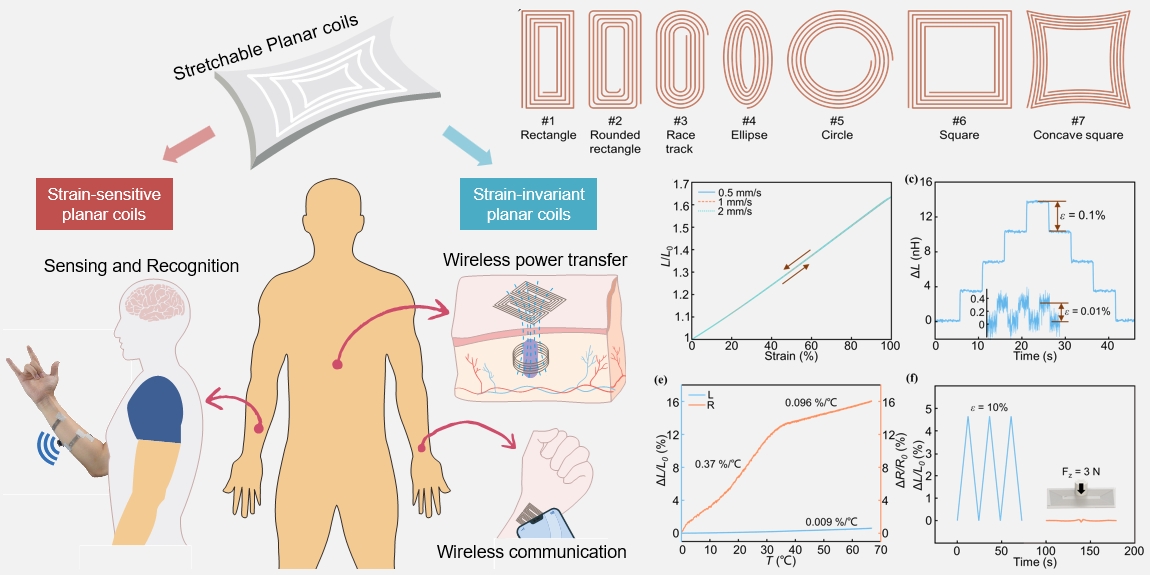
Programming Stretchable Planar coils
We identify that aspect ratio (AR) is the only determining parameter that affect the “inductance-strain” characteristics of stretchable planar. Theoretical analysis, numerical analysis, and experiments confirms the conclusion, and the strain sensitivity of stretchable coils can be adjusted over three orders of magnitude. Stretchable planar coils can be designed as high-sensitivity strain sensors with a detection limit down to 0.01% strain, as well as strain-insensitive antennas, exhibiting a maximum inductance change of less than 1% under 0–50% strain.

CNT network strain sensors
We presented a trace-polymer bonded CNT networks (TP-CNT) which has high conductivity like pure CNT networks, yet extremely good mechanical stability and stretchability like composite materials. The TP-CNT based sensor can be stretched up to 300%, and has a extremely low detection limit of 0.0024%, low hysteresis, linear response. It has proven to be capable of providing accurate monitoring of the expansion of the tracheal tube cuff, and can monitor the the swallowing-respiration coordination.

Inductive multimodal tactile sensor (IMTS)
Building on the characteristics of a inductive coil’s impedance when it is coupled with a conductive target via the eddy-current effect, we presented an inductive multimodal tactile sensor (IMTS) which measure the force and temperature simultaneously by monitoring the coil’s inductance and resistance. With an integrated CNT-based heating unit, the warm-IMTS can recognize the thermal properties of objects by a simple touch like our human fingers, and can also feel the wetness or the air flow.
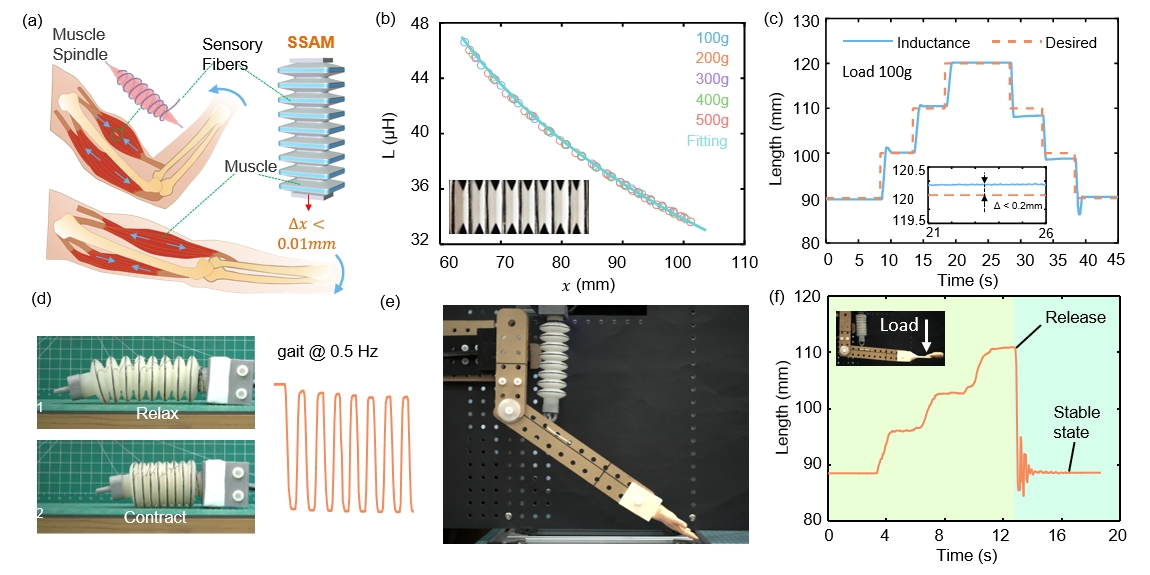
Self-Sensing Artificial Muscle
This work presents a self-sensing artificial muscle (SSAM) that can sense its length change as small as 0.01 mm via a seamlessly integrated multi-segment induction coil. The SSAM provides accurate length information regardless of its loadings, driving pressure, or muscle design, adequate for robust data-driven feedback control. An SSAM-based artificial arm is demonstrated for humanlike spontaneously perception, interaction, and sensing-based positioning.
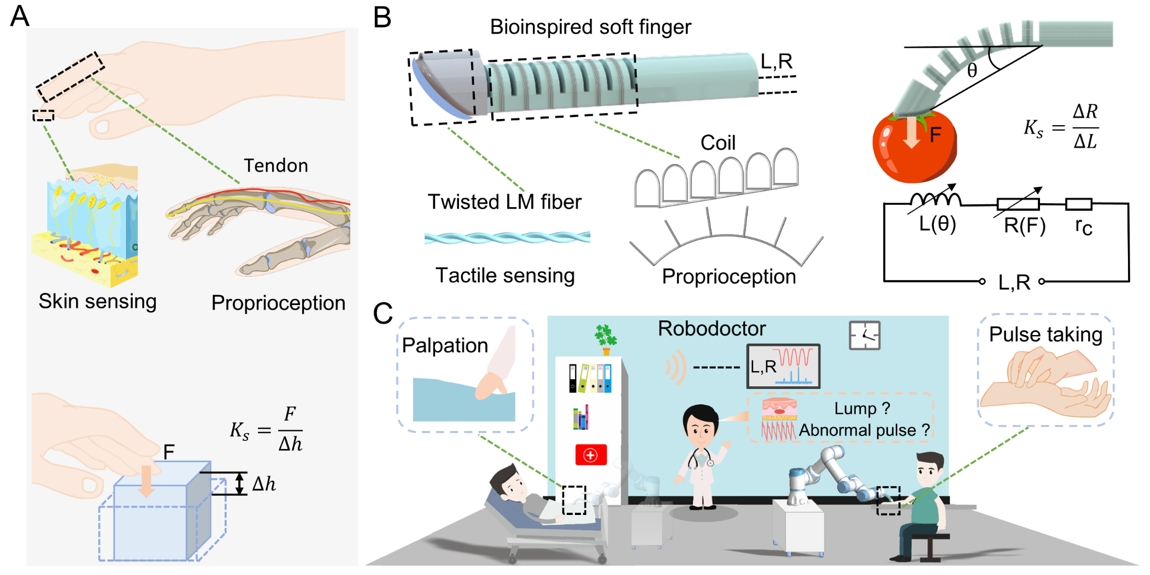
Robotic palpation and pulse-taking
Inspired by the human fingers, this work presents a biomimetic soft finger (BSF) with seamlessly integrated conductive fiber coil, which is capable of monitoring its bending angle and force at the fingertip with a resolution of 0.02° and 0.4 mN, respectively. The fiber coil's inductance decreases with the bending angle and its resistance increases with the force at the twisted LM fiber. The BSF can detect stiffness by a simple touch, and was demonstrated for lump searching and taking pulses like a “Robodoctor”.
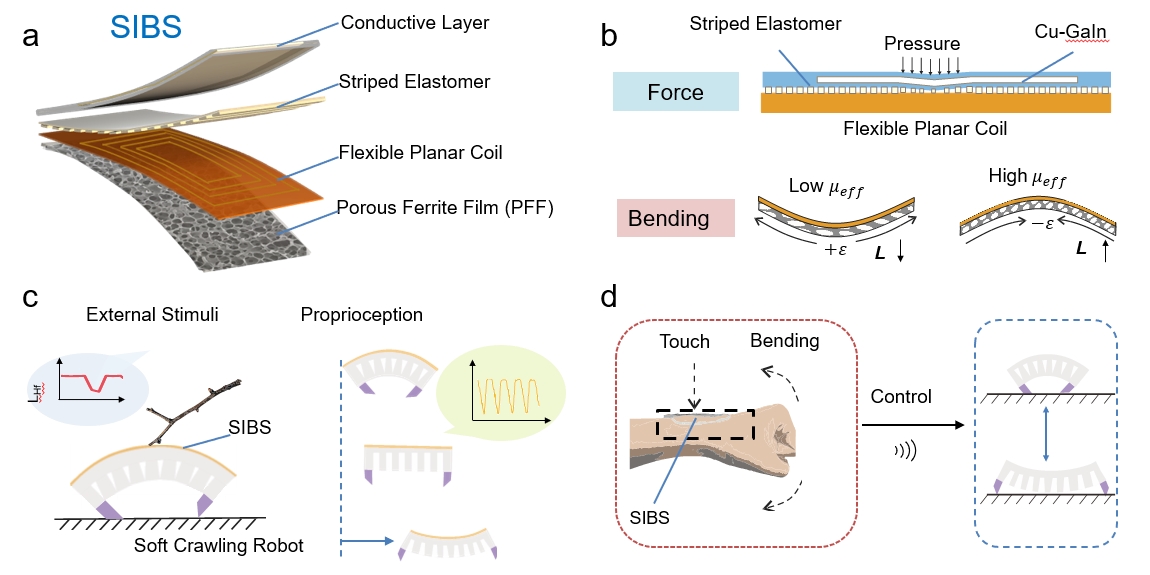
Soft Inductive Bimodal Sensor
This paper presents a soft inductive bimodal sensor (SIBS) with decoupled force and bending sensing by measuring the inductance at two different frequencies. The SIBS exploits the eddy-current effect at high frequency for 1 mN force sensing and the magnetic reluctance effect at medium frequency for bending sensing (0.44°). We demonstrated the SIBS for perception of a soft crawling robot, and as a wearable human-machine interface on the wrist to interactively control a soft locomotion robot.
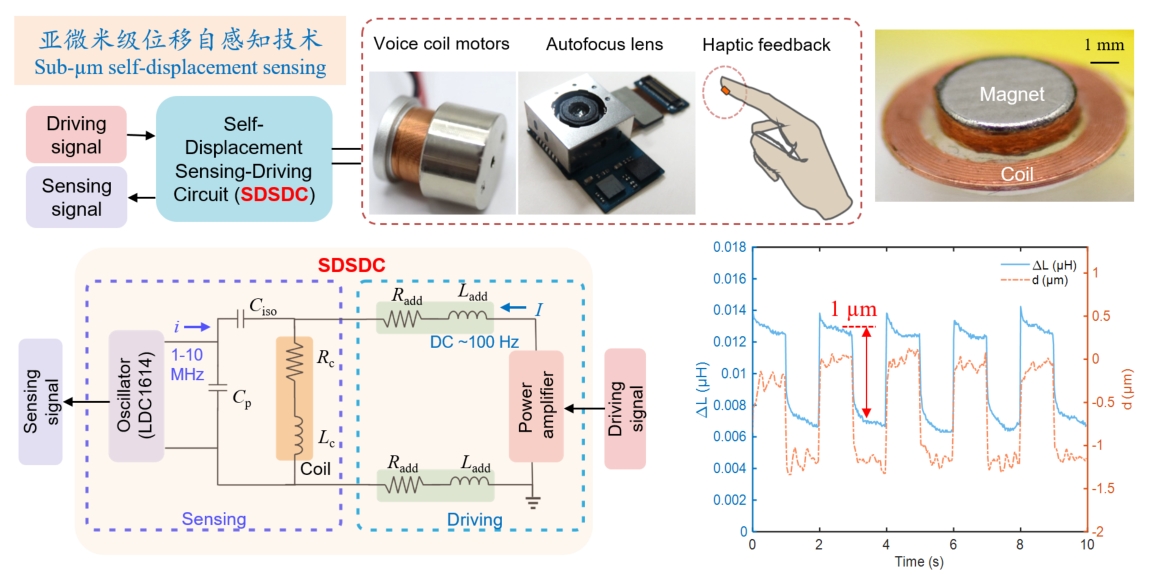
Sub-μm Self-Displacement Sensing
Here, we present a self-displacement sensing solution for SEMAs without requiring additional hardware. A self-displacement sensing and driving circuit (SDSDC) was developed and evaluated, in which low-frequency driving and high-frequency sensing signals can function simultaneously without interfering with each other, with a sensing resolution of 0.03 µm. It shows promising features for applications from auto-focus lens, voice coil motors, haptic feedback devices and metaverse.

Reconfigurable Multiaxis Force Sensor
This paper presents a fully integrated, reconfigurable MFS (RMFS), which utilizes an array of PCB coils to detect the multiaxis displacement/rotation of a metal target at high resolution without mechanical or electrical connections. The RMFS prototype achieved an ultrahigh resolution of 1 mN for triaxial force sensing in a range of 20 N. The RMFS shows promising features to be implemented in diverse applications from robotics, human-machine-interaction, and biomedical systems.
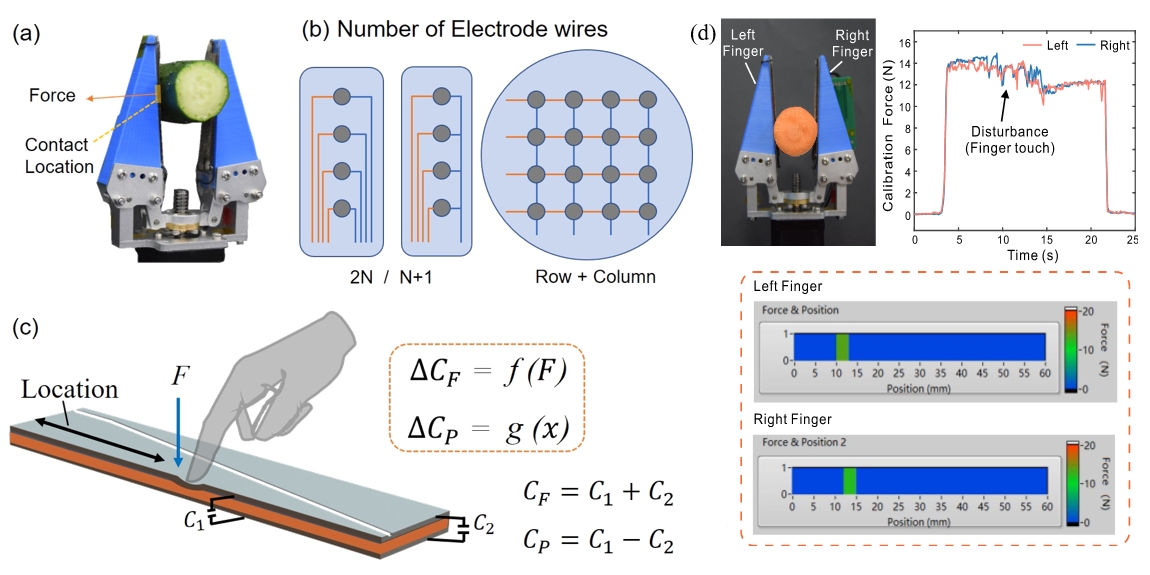
Nonarray soft tactile sensor
In this work, we propose a non-array soft tactile sensor (NA-STS) that utilizes two triangle textile electrodes and a rectangle electrode to form a pair of soft capacitive pressure sensors in a differential configuration along its length. The results show that the NA-STS can detect the force as low as 2.1mN and a maximum error of 2.5 mm for contact location. The NA-STS has a simple structure, high performance and rapid response, immune to proximity effect, and robust for real-word applications.

Printed Inductive coil array sensor
Here we presented a printed induction-based array sensor with only two signal terminals. It identifies the material species of approaching and touching objects and also recognizes the speed and shapes of the objects moving dynamically above the sensor. It is demonstrated that a finger-like array sensor with two terminals could provide a simple and reliable structural design for the new robotic applications of material recognition and stimuli position detection.

Split wearable angle sensor
In this work, we propose a film-like split angle sensor (FSAS) which operates through AC magnetic field coupling between a soft planar coil and a ferromagnetic or conductive target film. The FSAS has a split configuration, overcoming the movement impairment problem presented by the strain sensing approach. It was demonstrated for angle sensing and external force detection of a laptop lid, wearable angle monitoring of elbow, and perception of a pneumatic driven origami robot.
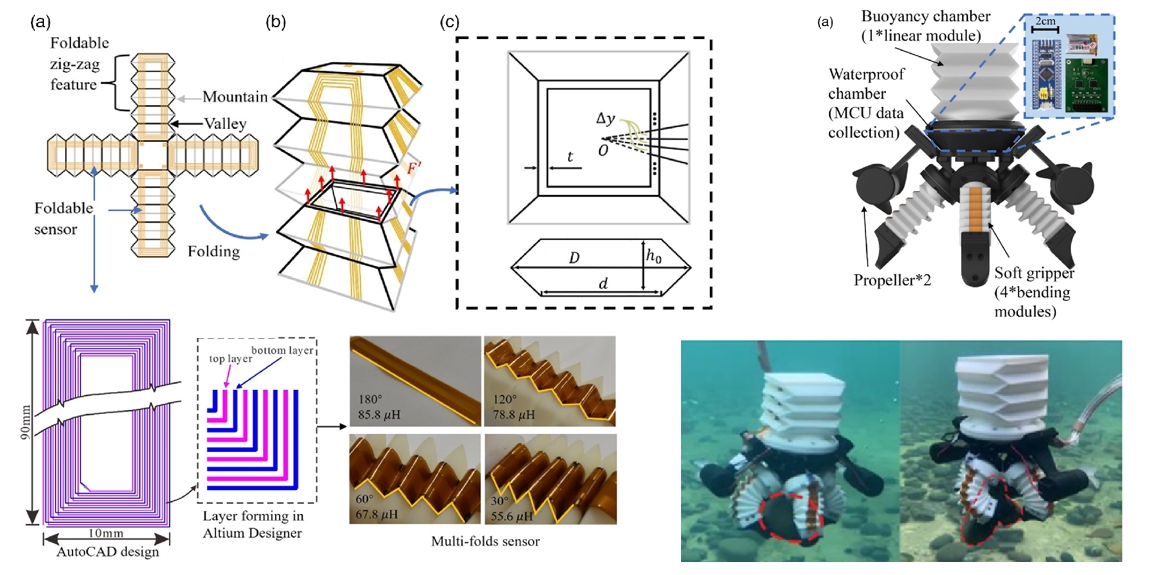
Perception of an Origami Robot
A reconfigurable and proprioceptive soft origami module is presented, where two actuation modes (i.e., extension and bending) are realized. Multimodal perception is enabled using a novel foldable self-inductance sensor. An intelligent gripper is capable of grasping mode adjustment, grasping force measurement, and the grasping target’s size measurement. Moreover, an intelligent jellyfish is presented, with buoyancy adjustment and underwater grasping capabilities.